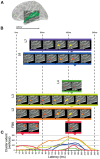On the similarities of representations in artificial and brain neural networks for speech recognition
- PMID: 36618270
- PMCID: PMC9811675
- DOI: 10.3389/fncom.2022.1057439
On the similarities of representations in artificial and brain neural networks for speech recognition
Abstract
Introduction: In recent years, machines powered by deep learning have achieved near-human levels of performance in speech recognition. The fields of artificial intelligence and cognitive neuroscience have finally reached a similar level of performance, despite their huge differences in implementation, and so deep learning models can-in principle-serve as candidates for mechanistic models of the human auditory system.
Methods: Utilizing high-performance automatic speech recognition systems, and advanced non-invasive human neuroimaging technology such as magnetoencephalography and multivariate pattern-information analysis, the current study aimed to relate machine-learned representations of speech to recorded human brain representations of the same speech.
Results: In one direction, we found a quasi-hierarchical functional organization in human auditory cortex qualitatively matched with the hidden layers of deep artificial neural networks trained as part of an automatic speech recognizer. In the reverse direction, we modified the hidden layer organization of the artificial neural network based on neural activation patterns in human brains. The result was a substantial improvement in word recognition accuracy and learned speech representations.
Discussion: We have demonstrated that artificial and brain neural networks can be mutually informative in the domain of speech recognition.
Keywords: auditory cortex; automatic speech recognition; deep neural network; representational similarity analysis; speech recognition.
Copyright © 2022 Wingfield, Zhang, Devereux, Fonteneau, Thwaites, Liu, Woodland, Marslen-Wilson and Su.
Conflict of interest statement
The authors declare that the research was conducted in the absence of any commercial or financial relationships that could be construed as a potential conflict of interest.
Figures






References
-
- Baevski A., Zhou Y., Mohamed A., Auli M. (2020). “wav2vec 2.0: a framework for self-supervised learning of speech representations,” in Proceedings of the 34th International Conference on Neural Information Processing Systems: NIPS'20, Vol. 33 (Vancouver, BC: ), 12449–12460.
-
- Bell P., Gales M., Hain T., Kilgour J., Lanchantin P., Liu X., et al. . (2015). “The MGB challenge: evaluating multi-genre broadcast media transcription,” in Proc. ASRU (Scotsdale, AZ: ), 687–693. 10.1109/ASRU.2015.7404863 - DOI
-
- Bishop C. (2006). Pattern Recognition and Machine Learning. New York, NY: Springer.
Associated data
LinkOut - more resources
Full Text Sources

